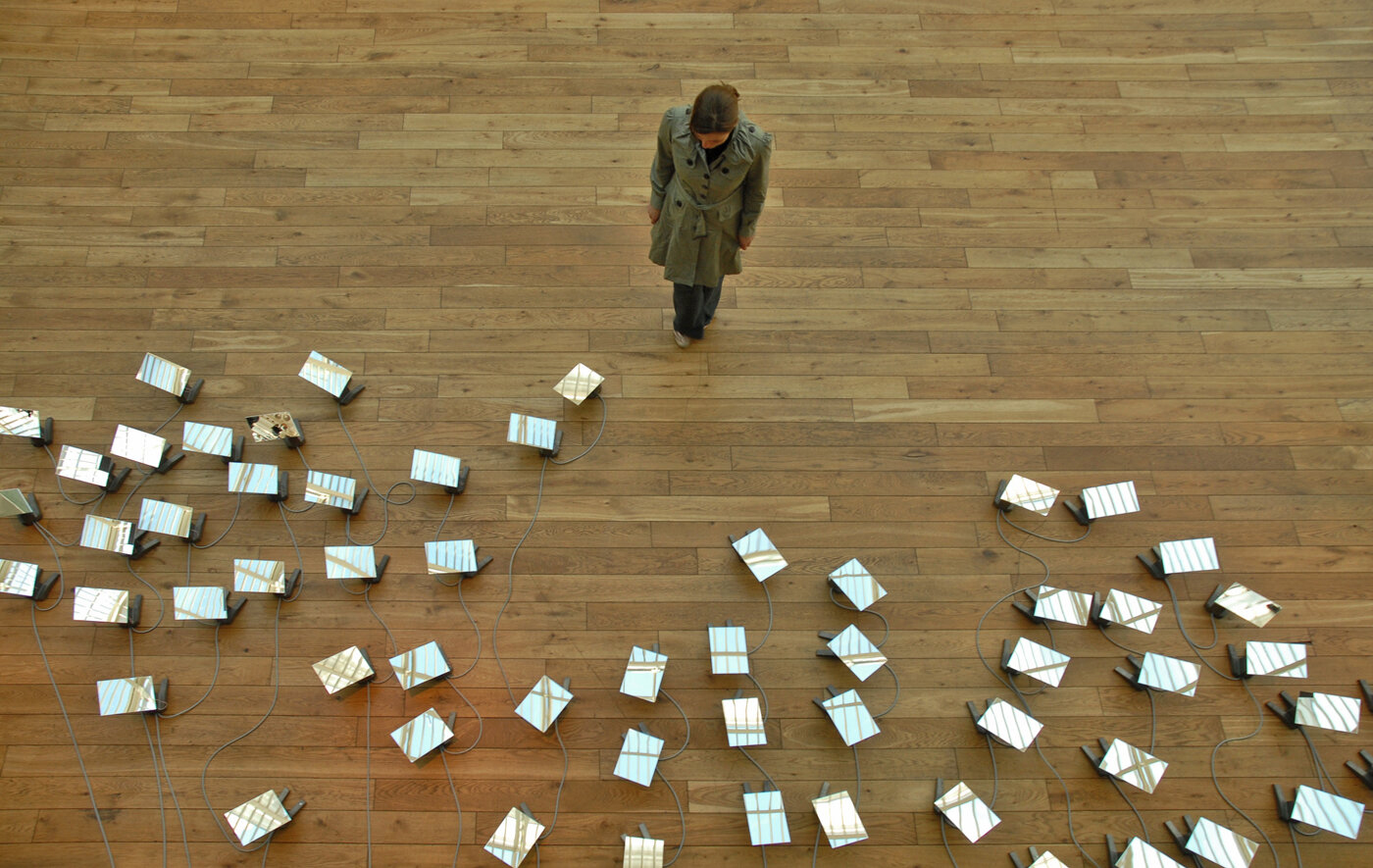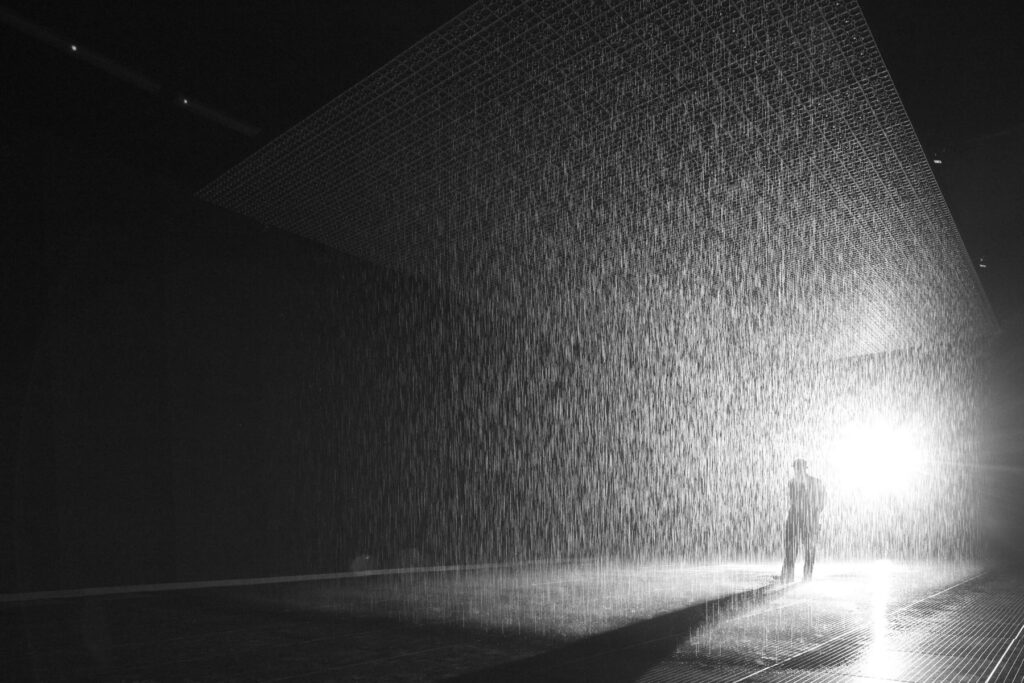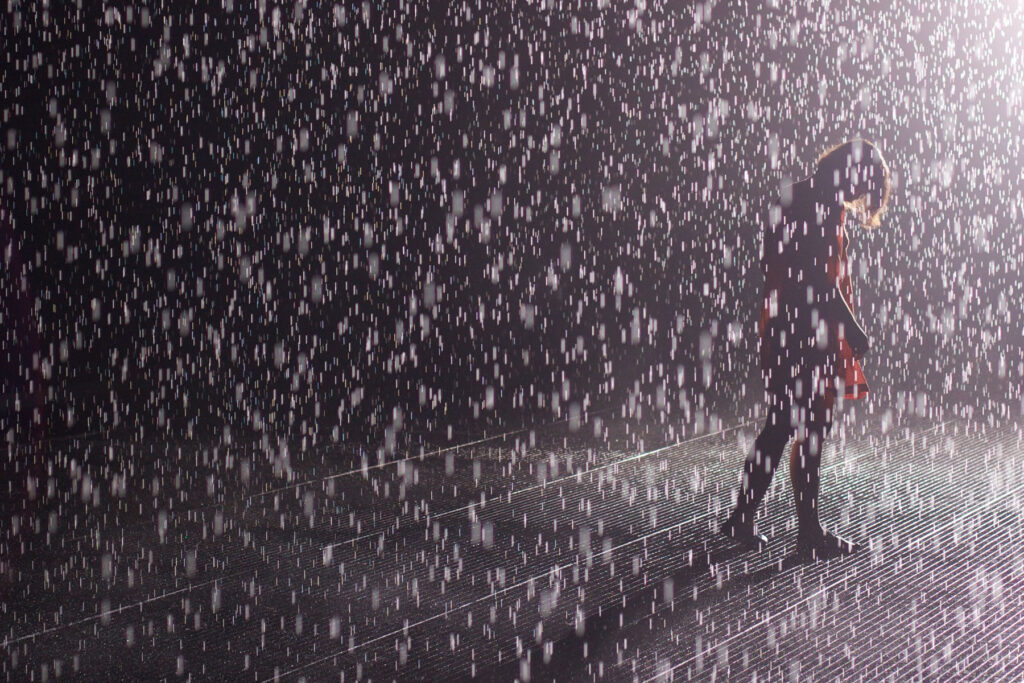Random International

“Don’t think about doing something too long; do it, and think with your hands while doing it”
Have you ever stood in the rain and not gotten wet? If you ever visit Rain Room created by Random International, a collaborative studio founded by Hannes Koch and Florian Ortkrass, then this is something you can experience for yourself. Rain Room is an interactive art work that uses motion sensors to allow visitors to walk through an artificial downpour without getting wet and is the work that thrust the art collective into the public eye in 2005. Since then Random International has continued to create work that invites the viewer to actively participate and questions “aspects of identity and autonomy in the post-digital age.” The collaboratives studio’s aim to “explore the human condition in an increasingly mechanised world through emotional yet physically intense experiences,” and they “aim to prototype possible behavioural environments by experimenting with different notions of consciousness, perception, and instinct.” NR Magazine joins Random International in conversation.

Rain Room is perhaps your most well-known work, but which of your other works was the most exciting to work on?
Audience (2008) was certainly a game-changer for us; it integrated several research directions that had been previously isolated: it looks at our emotional reaction to simulated life forms, it recognises body-in-space, and it starts to animate a more architectural sphere.
On the other end of the spectrum, we are enjoying working on Body / Light (2021), which is bringing an augmented and time-based elements into an immersive form of engagement.
Lastly, we’re in the pre-production stage/creation phase for a number of new bodies of work; while the pandemic has certainly been a huge challenge, it did allow space for deepening our experimentation with ideas, processes and technologies.
Are there any new technologies are you particularly interested in incorporating into your art practice?
Any technology that supports us in expressing ourselves in a language that everybody can understand is of interest to us…so we don’t really have any preferences. There are however various (diverse) areas of science that we’re paying a lot of attention to, such as different areas of decision making research, developments in machine learning, some obscure branches of behavioural science, cognitive neuroscience (focus on distributed forms of cognition), Kinaesthetic learning et al.
What do you think it is about interactive and immersive art that makes it so universally popular? Do you think peoples’ shortening attention spans due to the influx of information they receive each day from their phones will necessitate even more engaging works in the future?
There’s an analogue, physical component to engaging with a sculpture in a space that cannot (yet) be met by screen-based forms of engagement. Maybe humans are still designed to feel safe in a real, physical space where the known rules apply or at least most of them. So that’s why we continue to seek out and share real, physical experiences.
You have stated you are interested in examining our ‘automated future’, how do you think technology, particularly AI, will influence your lives in the future, specifically in the art world?
It looks like we’re increasingly surrounding ourselves with machines and processes that are designed to ‘read’ us, draw their own conclusions and then respond to us accordingly. All – as with most advancements in the past – to make our lives easier (predictive text actually suggested ‘easier’ after I typed ‘lives’ just now!) and safer.
The issue is that we’re not entirely compatible with those kinds of transactions; we are not wired to fully grasp the consequences of our actions and thus one could see us getting into all sorts of trouble, existential & comical alike. Questions re the transfer of agency (i.e. can an algorithm be an artist?), distributed creation processes and algorithmically curated experiences are probably some of the topics that we’ll see flaring up some more soon in the art world. Not to speak of entire macroeconomic ecosystems that are emerging (NFT’s) and likely here to stay.

Has the pandemic affected you and your approach to your art practice and if so how?
Yes. While we were already working very zoom based and in several countries/time zones already, we took the time to refocus our practice on some core themes and allowed ourselves the luxury to dive deeper into some of the topics that previously often dried up once a show was up or a commissioned work opened. Going for depth rather than breadth is something that was incredibly energising and something that we definitely continue to cherish and honour now that the pace is picking up again.
What do you want people to take away from your work?
A different perspective on the world and their own place in it.
In contrast to your use of technology, a lot of your work seems to be influenced by forms and phenomenons found in nature. Is this the case and if so why?
We’re obsessed with the ingenuity of our human species and the bandwidth of our perception, just how far and how deep it goes. So at the core of most of our work is the human form, the human condition and our emotional reaction to an increasingly automated and dematerialised world. Nature and natural phenomena connect us: to ourselves, to others and to the world around us. So they make brilliant material for art making!
How do you approach working collaboratively and what are some of the pros and cons of working as a collective?
We can’t not work collaboratively, it’s as simple as that. As a studio, we are a machine that is at its best when we generate knowledge and meaning in the creation process. Flo and I and the group that works with us do have a thing for communication; the complexity of the work dictates that we look at it from a lot of different angles. And our team, through brilliance and diversity, enables the studio to take on large, international projects in an efficient manner.
What advice do you have for young creatives who are interested in working with art and technology?
Don’t think about doing something too long; do it, and think with your hands while doing it.
Technology is a tool, not the aim.
Are you working on any projects at the moment and what plans do you have for the future?
We were commissioned by the BMW Arts Group to develop our work No One Is An Island in partnership with Studio Wayne McGregor and a score by chihei hatakeyama. Due to the pandemic, we had the opportunity to do an intimate rehearsal in London in October last year, and are planning to bring performances of that work to Frieze London in October 2021. We’re also working on several; different exhibitions and group shows to present a new body of work on Swarm Algorithms later this year, and we’ve celebrated three years since opening our Rain Room at the Sharjah Art Foundation this year. With Pace Gallery’s new spin-off Superblue, we’re working on several exciting outings so do stay tuned!
For more information, please visit random-international.com